Where were you the night of June 25, 1998?
January 13th, 2020

The June 25, 1998 blackout report needs to be on the interwebs available to the world.
June 25, 1998? That’s the night of the transmission fail that disconnected the Midwest from the Eastern Interconnect. That question was asked by Minnesota Power’s attorney of each and every witness, I think other than MP, but maybe MP witnesses too, in the Arrowhead transmission project hearing, circa 1999-2000. There were cries of “Hospitals will go dark without the Arrowhead project,” “We’re going to freeze in the dark in an incubator” which became “We’re going to freeze in the dark on a respirator without a job” — it was so histrionic.
The Arrowhead transmission project was project 13J of the WRAO Report, and the WIREs Report, which presented many transmission lines, but chose the Arrowhead transmission project as the “be all and end all” of transmission in the Midwest, that it would fix all the transmission problems:
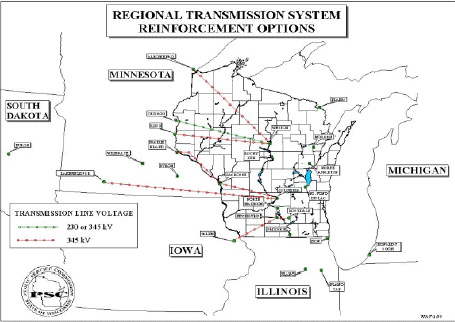
The hearing went forward, 2 weeks in Minnesota, where MP got an exemption from Minnesota Power Plant siting law, and for TWO MONTHS in Wisconsin, for Round 1, then 2 weeks after the cost went way up, and another 3-5 days of hearing later when cost went up again. They got their permit, it’s up…
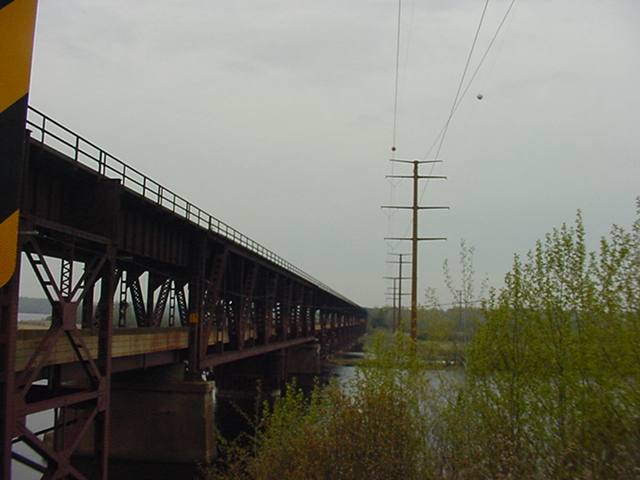
But in that first hearing, I did get to introduce the report that showed that the June 25, 1998, blackout was NOT caused by too little capacity, it was not caused by an unreliable transmission system. It was caused by corporate greed, transmission operators running the Prairie Island-Byron 345kV’s TCEX flow over the limit, disregarding operating guides, and disregarding requests and demands to ramp the power down, violating MAPP Operating Standards and NERC Operating Policies. SHAME, NSP, SHAME!!! And MP was so tacky, trying to attribute their desire for bulk power transfer to the blackout, that the Arrowhead project would save us. Yeah, right…
Here’s the report, below, it’s a gem, I’m posting this today because I’m shoveling off my desk and there are a lot of gems here, so posting them will get them out into the world in perpetuity — can’t disappear something from the internet! Scanning them in is taking a while, a royal and dusty pain in the patoot, but just for you inquiring minds, HERE IT IS:
Here are a couple snippets, starting with p. 2:
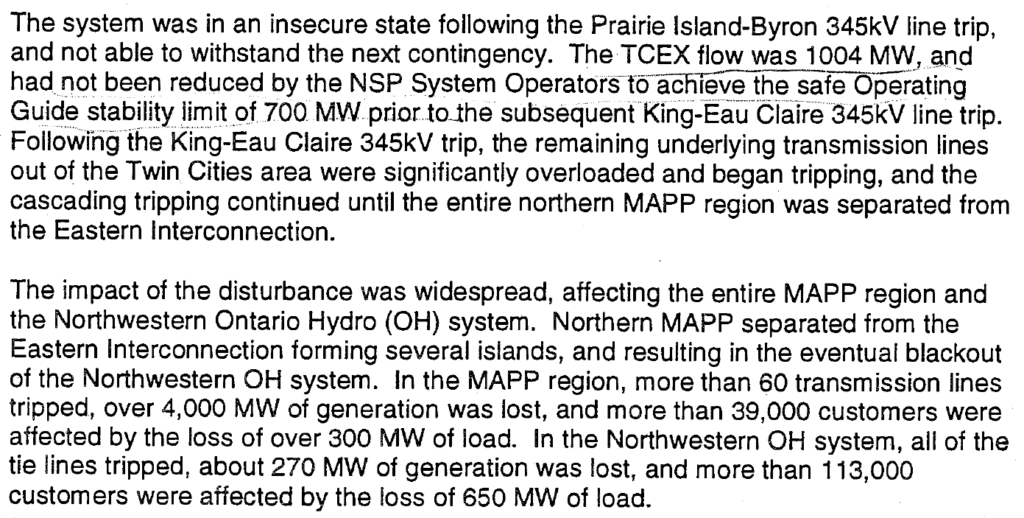

Bottom line?
OPERATE WITHIN OPERATING GUIDE LIMITS!!

DOH!
The report goes on and on with stupid human tricks – the flow was NOT reduced by NSP System Operators:

From pps 10-11:


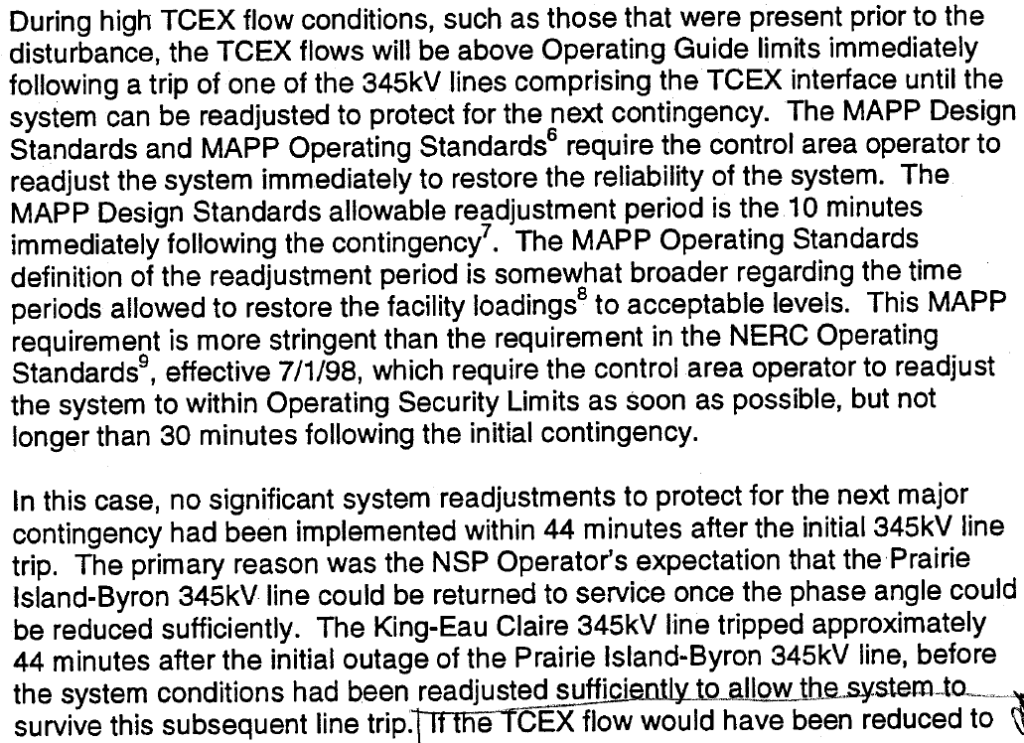

So if the operators had been doing the job, not focused on keeping that line operating with all that power flowing through it, selling that power, the blackout may not have happened. Great…
And for some reason, NSP operators were not communicating:

300 MW above the operating guide limits:
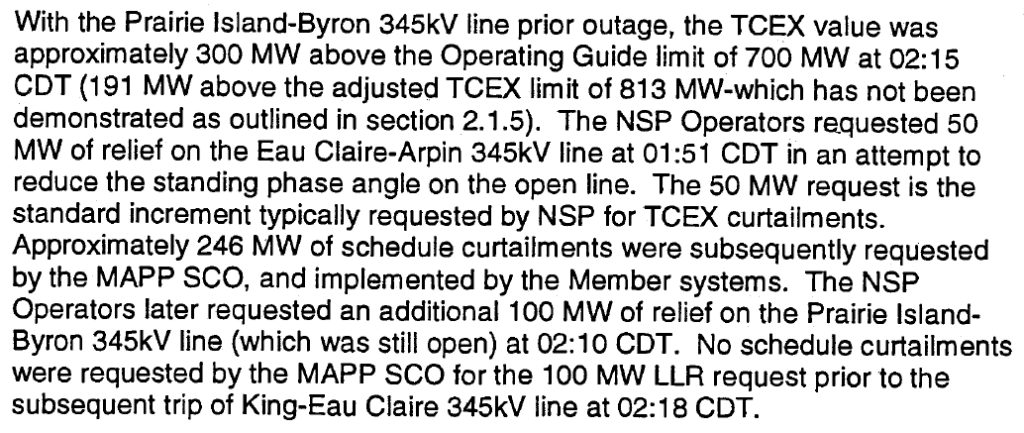
OPERATE WITHIN OPERATING GUIDE LIMITS!! DOH!
Operator error is a too-generous way to put it — but for the efforts to NOT reduce power flows, the inadequate response of system operators and their failure to communicate the degree of the problem, the blackout may not have happened. And then utilities have the nerve to say that because of the June 25, 1998 blackout, we need the 13j Arrowhead transmission project?
MAPP transmission line under the microscope
September 26th, 2009
Before we get started, a note about need. As usual, this transmission line is not needed. PEPCO’s Mid-Atlantic Power Pathway, or MAPP line, not to be confused with Mid-Continent Area Power Pool (MAPP), is the red line on the map above. PJM, the private utility transmission promotion entity, has admitted that the Indian River to Salem part of the line is not justified, and have taken it off their wish list. Now, about the rest of it…
And where did MAPP come from? It’s part of Project Mountaineer, which is planned to bring cheap coal generation from the Amos plant and others, like the coal plant planned by Delaware Electric Co-op. Without this transmission line, the coal generation would not be used in the Mid-Atlantic or parts further NE, i.e., New York.
The MAPP transmission line had a day of scrutiny last week when MAPP opposition groups hosted a tour and luncheon featuring former Maryland Gov. Harry Hughes speaking against the line. State Senators and staff from both Maryland U.S. Senators were present, and it looks like they got an earful and eyeful! They used balloons to show the height of the lines, as we did in Susquehanna-Roseland last month, and Chisago years ago.
Here’s the full story:
Tour focuses on MAPP problems
By DUSTIN HOLT Special from The Star DemocratPublished: Friday, September 25, 2009 9:56 AM CDT
The Eastern Shore Land Conservancy and the Dorchester Citizens for Safe Energy along with the Dorchester County Tourism Department organized a tour through Dorchester County last week to show the impact the proposed Mid-Atlantic Power Pathway project would have on the county’s heritage, agriculture and wildlife.
Pepco Holdings is proposing a 27-mile high-voltage electrici transmission line crossing Dorchester County as part of the MAPP project, from Taylor’s Island to Vienna.
The ESLC suggests the towers would be 150 feet tall, though Pepco puts them between 110 and 130 feet. According to the ESLC, the towers would consume 650 acres of county agriculture, forest and rural lands.
The Sept. 16 tour included lunch at the E.A. Murphy Community Center in Vienna, with former Maryland Gov. Harry Hughes as a guest speaker.
“Many of us are opposed to it (the MAPP Project) because insufficient studies have been done for this line,” said Hughes, an advisory committee member of the ESLC. “Have they looked at alternatives?”
Hughes said one alternative is to improve the Vienna Power Plant, which is not operating at full power. He said another alternative is to introduce energy conservation standards to reduce the need for the power lines.
“This is a massive project that will disrupt the landscape,” Hughes said.. “There are too many unknowns with no alternatives considered. As far as I can see, there is no need to rush into this.”
Vienna Mayor Russell Brinsfield, one of the founders of ESLC, said MAPP would permanently and negatively impact Vienna. He said alternatives should include the state promoting energy conversation and renewable resources.
State Sen. Richard Colburn, R-37-Mid-Shore; Del. Addie Eckardt, R-37B-Dorchester; and Jeannie Haddaway-Riccio, R-37B-Talbot, were in attendance at the lunch in Vienna.
Eckardt said it is important to preserve the heritage and agriculture in the county, “Our biggest asset is our land, fisheries and agriculture.”
If MAPP project must move forward, Eckardt said, the state needs to look where the project will not be environmentally sensitive nor impair the landscape of the county.
The tour headed from Vienna, through Blackwater National Wildlife Refuge and back to Cambridge.
Dorchester Citizens for Safe Energy Chairman Libby Nagel said the power line would require about a 200-foot right-of-way.
To demonstrate the height of the towers, balloons were deployed to a height of about 150 feet.
Local farmer Lin Spicer said spraying crops would be ineffective with the power lines because planes would not be able to get below the lines. “We would be forced to spray from above the towers and the wind would blow the spray all around before it reached the crops,” he said.
Blackwater Manager Susan Baird said the MAPP towers would have a great impact on wildlife and wetlands. She said bald eagles need a living area of at least five miles. “They won’t fly over the towers, so you can’t tell me they or other birds will not move on to different locations outside of Dorchester County if the power lines are put here,” Baird said.
In Grist today: Transmission Lies
February 3rd, 2009
Against the so-called ‘need’ for new long-distance, high-voltage transmission lines
Posted by Guest author (Guest Contributor) at 10:31 AM on 03 Feb 2009
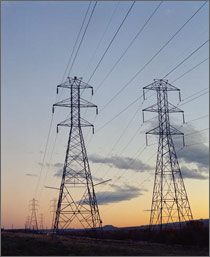
Transition … transmission … transition … transmission …
That old Bowie hook is on my mind as I represent individuals, community organizations, and local governments opposing high-voltage transmission lines. Today we’re at a crossroads in energy, a transition point where the decisions we make, like electricity itself, are binary. What we choose will determine how we use electricity in the future. The first step is to carefully define “need.”
Transmission doesn’t produce electricity. It is passive infrastructure that just sits there, conducting energy from one place to another. At its worst, though, it’s an enabler of dysfunctional energy planning and profit-driven projects that are against the public interest. Claims that we “need” transmission are end-stage conclusions of a many-step planning process that we as a society have not yet consciously begun.
“Need” is a term of art, and the crucial task for energy planners is to define the need. We need energy when we flick the switch, and when we do, that’s a utility’s need for service of local electrical load. We also need renewable generation, and we have an equally compelling need to reduce the CO2 emissions, pollutants, and toxic waste of electrical generation (a need not readily recognized in energy planning). Energy planners plan for peak “flick of the switch” need, those few very hot summer days or very cold winter nights. How much “flick of the switch” energy do we need? It depends.
Prior to assessing local load-serving need and making demand projections — before “need” is considered — the first and unarguably least-cost step is conservation. We can easily make up for an annual projected increase in demand of 1.5 percent through conservation, and can probably cut today’s “need” by 10 percent or more, though compound conservation gets more difficult as we cherry pick the easy stuff. The next step before analyzing need is to enact energy efficiency, demand-side management, and load-shifting to cut the peaks and level out the dips. This is also a comparatively least-cost means of meeting demand.
When that’s done, and not before, it’s time to assess our need for electricity — the supply side. Utilities, which are in the business of selling electricity and building their infrastructure — for which we pay, routinely promote sales and exaggerate growth in demand. Because of their overstatements of need in similarly recessionary times, we overbuilt in the 1970s, to the extent that many proposed plants were ultimately canceled. Still so much was built that we haven’t needed much utility infrastructure since. We’ve been through this before, and should be mindful in making investments.
Because of the recent utility industry shift to market-based dispatch, whereby generation is no longer strictly for service of local load but for wider regional or national electricity markets, market expansion has become the driver for the utility “need” for transmission. This is the key difference: how much transmission utilities need to serve their local load (the public good) vs. how much they need to participate in markets (greater profits). North American Electric Reliability Corporation (NERC), the private overseer of all things transmission, admits in Reliability Assessments that there is a lot of new electrical generation planned and that the transmission system is sufficient to meet local load-serving needs. The confounding factor: NERC notes that the transmission grid is constrained in places and is not sufficient for market purposes, for market expansion.
The short explanation of the shift to market focus is that, in theory, it makes generation available to all who want it, based on price rather than location. The cheapest is sold first, and buyers queue up in line. But the sale price is busbar price at the generator or seller, and does not take into account the costs of getting it from here to there — notably transmission construction, transmission service, and line loss. These costs are tacked on and billed to the purchasing utility, and will be added to the customer’s bill. The market “price” thus appears misleadingly low. Cheap coal-generated electricity from West Virginia looks awfully good to buyers in New Jersey when all the costs aren’t factored in to the sale price.
This is the crucial point: The divergence between traditional “local load-serving need” and the desire of utilities to beef up need claims, to build generation and transmission at ratepayer expense, in order play the market. State regulatory proceedings are couched in traditional “local load-serving need” terms, and utilities must prove up need before they are granted Certificates and proceed with construction. Investments must be “reasonable and prudent.” Opportunity to play the market is not reasonable and prudent, so it’s not a reason to build a transmission line — utility desire to increase market transactions is not recognized as “need” in a Certificate of Need or Certificate of Public Convenience and Necessity proceeding. This is where transmission lines become transmission lies: Transmission projects for market trading are couched in terms recognized by regulators.
Planning for “peak load” is a transmission lie. Utilities have incentive to overstate “need” when they build for peaks. The higher the peak they build for (with peak occurring only several times annually), the deeper the off-peak valley and the more electricity they can sell on the market when generation is available but not “needed.” Conservation and peak-shaving is against their interest because it lowers peak and lessens the valley of market sales.
“We’ll have blackouts” and “we’re going to freeze in the dark” are transmission lies. A review of recent blackouts — the ones used to justify transmission projects — shows that they occurred during off-peak times where utilities were overloading the lines, pushing more electricity than the system could handle. Despite warnings that the system was at risk, operators did not cut back on loading. An industry report on one blackout during “light load condition and low cost Mid-Continent Area Power Pool (MAPP) generation,” while “there were high simultaneous exports,” concluded:
This event should not be filed away as just another close call. We need to recognize just how close we were to collapsing portions of the Eastern Interconnection and adjust operating guides and reporting practices to avoid recurrence. There are real limits to the transfer capability out of the MAPP region and those limits are interdependent. This event is an alarming representation of how the MAPP regional interconnected system is being operated at and even beyond its capabilities.1
Utility “forecasts” are a lie. Despite their propensity to overstate need, several utility CEOs recently admitted that use has decreased from 3-9 percent, and that future infrastructure projects should be reconsidered. If we’ve moved from 1.5-2 percent projected growth to 3-9 percent decrease — with no increase in sight — that 4.5-11 percent drop in forecasted demand will substantially alter projections for years to come. The longer that drop continues, the further out it will affect projections. Despite this change in use and extension of “need” out in time, utilities are holding on to outdated projections. They still want to build infrastructure based on inflated “need,” infrastructure that we will pay for — and pay them a percentage return on investment. If approved, utilities will cover costs and make a return whether it is needed or not.
“It’s for renewable generation” is a lie. The massive transmission infrastructure expansion proposed is not “for renewables” because transmission may not discriminate by generation type. Federal regulations prohibit discrimination among generators — it’s first come, first ready, first served. There are tens of thousands of megawatts of coal projects, with transmission studies complete or in progress, waiting for interconnection, and whatever generation is ready will be connected. Another side of this lie is when wind advocates support transmission, claiming “it’s for renewables,” and ignore the impacts of transmission on the communities it traverses. Rather than make this convoluted “it’s for renewables” claim, there’s a better way: if renewable energy mandates were directly linked with shut down of fossil generation, and if renewable generators were thoughtfully sited, both the electricity market and transmission infrastructure would be open and available.
“Long distance transmission” is a lie. Transmission is inherently inefficient over long distances. Transmission physics entails high levels of line loss, and the longer the line, the higher the line loss. To avoid this fact of physics, the electric industry has shifted its line loss analysis for new projects to a “system wide” loss, so the numbers look low. But consider actual numbers of megawatts of line loss, and look at “coal plant equivalents” to make up that loss — for every 500-600 MW of line loss, a coal plant or more would have to be built! Line losses are charged in Federal Energy Regulatory Commission rates, but this is not considered directly in the market transactions. Line loss is an afterthought add-on to the customer’s bill after transmission service is provided. Consider too the capital cost of transmission, starting at about $1.5 million per mile for 345kV lines and upward from there.
Utilities’ frame of “need” for “public purpose” is a lie. Most transmission regions of the country are now planning transmission expansion to make their markets workable — to be able, theoretically, to ship power across the country. For example, in the Midwest, it’s the Midwest Transmission Expansion Plan. In PJM on the east coast, it’s the Regional Transmission Expansion Plan. These plans are all market-based, but for those transmission projects in states that regulate transmission, they’ll couch “need” in terms recognized by the state to get the approvals they need.
For example, CapX 2020 in the Midwest is framed for Minnesota regulators as needed for “local load-serving,” “regional reliability,” and “generation interconnection” — despite being an obvious expansion for coal through Minnesota to points east. The Mid-Atlantic Power Pathway is framed as necessary to serve local load in the Delmarva peninsula, despite being an obvious pass-through from West Virginia coal to New Jersey, connecting major power plants for export to the Northeast. Utility framing of this market-based, profit-based purpose as public purpose “need” also serves as their basis for taking land through eminent domain, because a corporation’s private purpose is expressly prohibited as justification for a taking.
Will we fall for transmission lies? Is new transmission a public purpose, a public need, provision of an essential service for a utility’s service area? Or is it an industry grab for market opportunities and profits at the public’s expense?
In my years of practice, I’ve yet to see a transmission line actually meant for the “need” proposed. We must take a critical look at these projects’ claims, because we’re the ones who will pay, and the lines will go over our land. Odds are, it’s private-purpose infrastructure that commits us to 50 or more years of wrongheaded, inefficient, and polluting central-station generation.
Electricity is binary, as is our situation now — we’re at a point where we must choose our path.
(Special thanks to electrical engineers Art Hughes, David Blecker, and Rick Gonzalez for making me learn about losses, planning, need, and powerflows.)
—–
1 Nebraska Public Power District, Report on June 10-11, 1997 Disturbance. See also Northern MAPP/Northwestern Ontario Disturbance — June 25, 1998 — Final Report; NERC Investigation of August 14, 2003 blackout.
